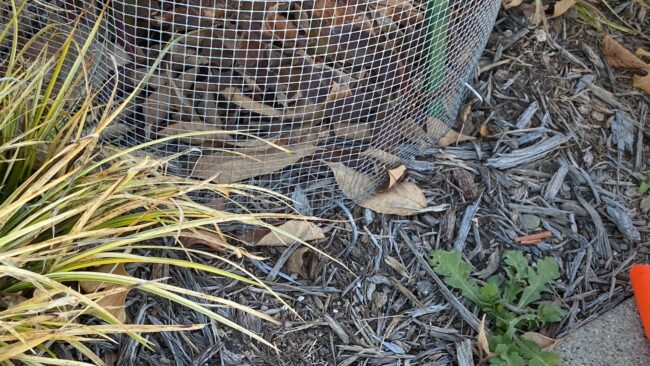Before the ground freezes too far down, it is a good time to put protective fencing around trees and shrubs that may experience damage from deer, rabbit, vole, or mouse feeding over winter. Fruit trees, crabapples, burning bush, shrub hibiscus, Fothergilla, young witch hazel, low-growing junipers and arborvitae are among the plants most commonly damaged, but almost any woody plant can be a target when food sources are scarce and snow is deep. Young trees are especially at risk since their bark is thinner and more attractive to hungry wildlife. Here at the Dane County Extension Teaching Garden (https://dane.extension.wisc.edu/horticulture/teaching-garden/), we have had voles chew bark off the undersides of branches on low-growing forsythia and junipers.
One of the best materials to use to protect your plants is ¼” mesh-size or ½” mesh-size metal hardware cloth. Chicken wire has holes large enough for voles and mice to slip through, so it is not as effective at preventing damage. The ¼” mesh-size hardware cloth is usually available in heights of 24” and 36” and can be purchased in rolls at home improvement and hardware stores. The ½” mesh size is often available in a taller 48” height size, as well. Some hardware stores carry it as a bulk roll and allow you to cut it to custom widths if you only need a small amount. I prefer to use the 36″ or 48″ tall mesh in case the snow is deep; it also offers the most protection against buck-rub deer damage on tree trunks. Be sure to use gloves (preferably leather or thick rubber!) when handling the cut edges of hardware cloth as it is very sharp. You will need a pair of strong tin-snips to cut the wire. Safety goggles are a good idea as well, since the cut roll tends to snap back into a cylinder shape after being cut.

Splay the mesh out around the bottom of the trunk so it is flat to the ground. Use sod-staples (also called landscape stakes or staples), which are 4-6″ U-shaped rigid metal stakes to pound through the holes in the mesh into the ground to prevent rodents from tunneling under the mesh. If the ground has frozen in your yard, you will need a metal mallet (maul) or a hammer to pound them in. You can also mound a couple inches of bark on top of the area where the wire and ground meet for extra protection, or add bricks or rocks to hold it down. The edges around the sides of the cylinder can be fastened together with thin rubber-coated wire or short cable ties threaded through the mesh for easy removal in spring.

For some shrubs here at the Dane County Extension Teaching Garden, we even screen over the top of certain shrubs if deer reaching over the top of the wire to munch on branches has been an issue. Remove the cages in spring once mid-April comes and the grass is greening up. By that time, the wildlife usually have less interest in chewing on bark as they have more palatable plant material around. Here is a link to a short video of this process: tree shrub protection video .




